Be Your Own Lawn-Care Professional

Homeowners really love their lawns. We love them so much, in fact, that we lavish affection on our turfs—to the tune of $40 billion a year—in the form of fertilizer, weed and pest controls, and yard-care equipment. But buying stuff in hopes of having a lush lawn has nothing to do with actually knowing how to grow one.
That’s why we’ve assembled all of your toughest lawn care questions and a TOH pro’s answer to each one. It’s all here: From seeding a brand new lawn and maintenance musts, to how to win the war on weeds and keep your mower in top shape. So forget hiring landscapers! You can be your own lawn-care professional— at a fraction of the cost.
Getting Started & Maintenance Musts
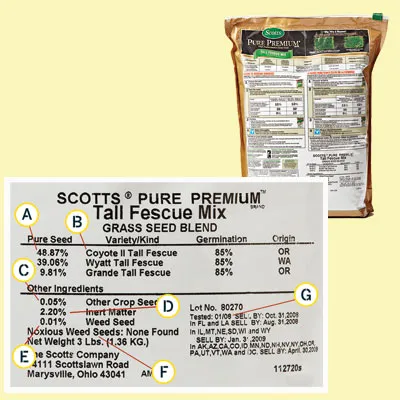
Reading a Seed Bag Label
Q: Can you help me decipher all the information on my bag of grass seed?
A: Here’s what each of the important label elements (shown left) mean:
A_Pure Seed: Look for a blend of two or more varieties. A single variety is more susceptible to being wiped out by disease.
B_Variety: Every common grass, such as tall fescue, should have a variety name. If no variety name is listed, it’s a lower quality seed.
C_Other Crop Seed: These are annual grasses, such as winter wheat or rye. Be wary if there’s more than 2.5 percent.
D_Inert Matter: This is the stuff that won’t grow, such as dirt and broken seeds. More than 3 percent is a red flag, unless it’s a seed coating meant to enhance germination.
E_Weed Seed: No bag is completely weed-free, but avoid ones with more than 0.2 percent of these seeds.
F_Noxious Weeds: The best bags will have none of these invasive plants.
G_Tested: Similar to an expiration date. Walk away from bags with a test date more than one year old.
Making Bad Soil Better
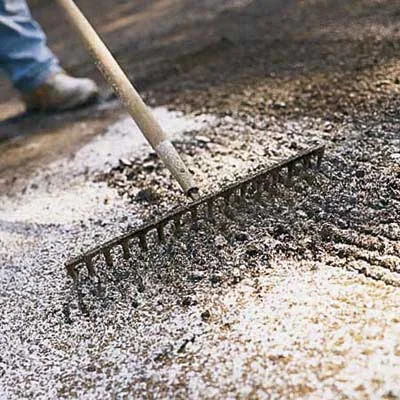
Q: The contractors who cleaned up the oil spill on our property tried three times to plant grass on the fill they brought in, but only weeds came up. I’m enclosing a packet of the fill for your inspection. What will we have to do to get a nice lawn?
—Margaret Kachur, Rahway, N.J.
A: Roger Cook replies: There’s no way grass is going to grow in that rocky soil. It should have been screened before it was delivered to remove all the stones, twigs, and other debris.
Here’s what to do. First, remove the top 4 inches of fill and discard it. Then dig up about 2 cups of soil and send it—without rocks and twigs—to be tested by your local cooperative extension service. They’ll send you back a report letting you know what nutrients it needs.
While you’re waiting for the report to come back, start by loosening up the fill with a rototiller. Then add 2 inches of sand and rototill again, followed by 2 inches of compost. Till that in, too. Now, grade the area with a rake and remove as much large debris from the surface as you can.
When you get the soil report, add the nutrients it calls for, plus a starter fertilizer for lawns, then rake in the seed. Keep the area moist, and I’ll bet you’ll soon be rewarded with a thick crop of grass seedlings.
When to Plant Grass Seed
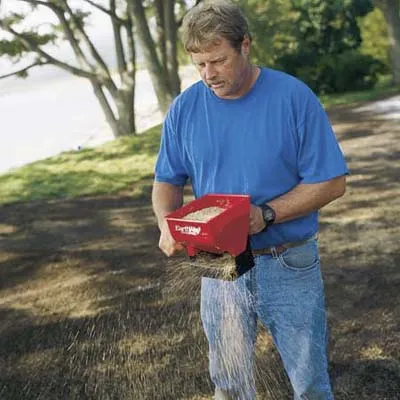
Q: What’s the best time of year to plant grass seed? And should I seed and fertilize at the same time?
— Rick, Seymour, CT
A: Roger Cook replies: In much of the country, grass seed is best planted before or after summer. That’s primarily because it’s almost impossible to keep new seed moist in the summer without nearly constant watering. The other problem with summer planting is that the soil prep work opens up the area to weed seeds, which readily germinate in the heat. (If you simply must plant in hot weather, mulch the planting area with a light layer of peat moss or similar material to prevent the seed from drying out.)
Where you live, and throughout much of the northern half of the U.S., early fall is the best time for sowing grass. The soil is warm, but daytime temperatures are moderate, making watering less of a problem, and the weeds won’t grow. I’ll start seeding in the last week of August and will push into the first week of October if I have to. By the cool days of late October, the new grass should be fresh and thick and strong enough to survive the winter.
Apply a starter fertilizer when you sow the seeds, and then add more fertilizer three to four weeks later. That’s necessary because all the watering you do to make the seeds sprout actually leaches the first application of fertilizer out of the top layer of soil, putting the rest beyond the reach of the young roots.
Shortcut to Skip
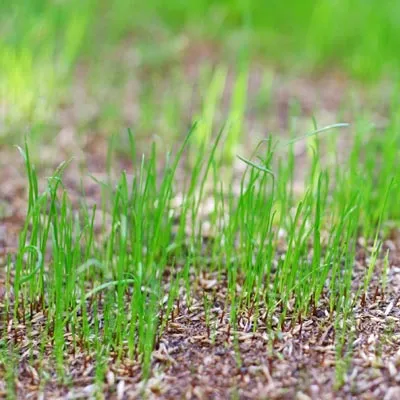
Q: Is it possible to plant seeds and mulch at the same time, or should I wait until after the seeds have come up?
—Barb, Worthington, Minnesota
A: Roger Cook replies: If you mulch at the same time you plant seeds, chances are your seeds won’t germinate. The mulch can literally smother new seedlings, or keep the soil so cool that the seeds can’t germinate. I know it’s hard to mulch after the seeds have germinated, but you will have to take your time and carefully mulch around the seedlings.
One solution is to germinate your seeds in flats or six-pack trays. Then you can mulch your beds first, and then, when the seedlings are properly rooted, plant them through the mulch and into the soil.
Fertilizing Facts

Q: I forgot to fertilize last fall! Am I doomed?
— John Farrow, Boise, Idaho
A: If you didn’t fertilize last fall, resist the urge to double up in the spring. Dumping more fertilizer than the lawn needs in the spring is wasteful and can burn your turf. Instead, spread 32-0-4 grass fertilizer after the first mowing, then again four to six weeks later. Organic lawn food, such as corn-gluten meal or a mix of feather, bone, and blood meals, works more slowly than synthetic fertilizers, so the lawn will take an extra week to green up.
Shown: TOH landscape contractor Roger Cook relies on a broadcast spreader to add fertilizer because it reduces the chance of missing a section, which can lead to unsightly growth patterns.
Compost for Lawns
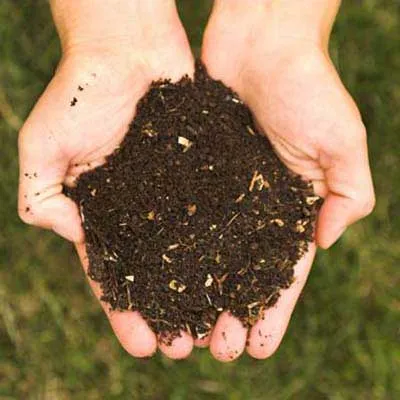
Q: How much compost should I spread on my lawn in the fall?
—Sue Fusconi, Stonington, Conn.
A: Roger Cook replies: Compost is a great way to nourish roots and make a lawn stronger and greener. If you just spread compost on the surface, then 1/2 inch is about all you can add at one time without harming the grass. But you’ll get much better results if you aerate the lawn first and get the compost down where it will do the most good.
The best way to do this is with a core aerator, which peppers the lawn with 2- to 3-inch-deep holes so air and nutrients can reach the roots. You can rent one and do the work yourself or turn it over to a lawn pro. After aerating, spread 1/2 to 1 inch of compost over the lawn and work it in with a plastic leaf rake. While you’re at it, this would be a good time to add your usual fall fertilizer. Finally, give the lawn a good watering to work the compost down into the holes.
By the way, fall is about the best time to do this work. Aerating any earlier in the year encourages weeds to get a start.
The War Against Weeds
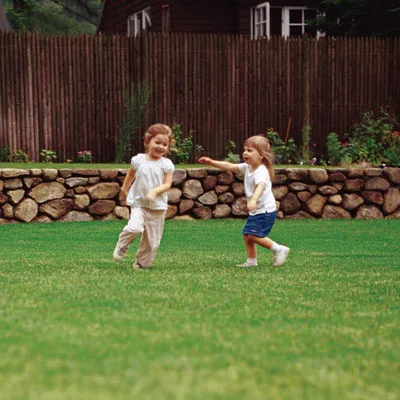
Nontoxic Weed Killers
Q: Could you please recommend a weed killer that is safe to use where children and pets play?
—Sara, Iowa City, Iowa
A: Roger Cook replies: I can’t recommend a specific product, but I do have some suggestions for you so you don’t have to use a large amount of weed killer. Remember that the stronger your lawn is, the fewer weeds you’ll have to deal with in the first place. Fertilizing properly, adding lime to control acidity, mowing to the correct height, and watering and aerating regularly will all promote a stronger lawn. Pruning or removing trees to promote more sunlight is also important.
If you are going to use a weed control, talk to your local garden center. Find someone knowledgeable about weed control chemicals and have him or her go over the label with you. With a granular formula, the whole yard is covered. To cut down on the amount of weed killer you will need, consider a liquid instead. You can put it into a small sprayer and walk the yard with it, spraying only the areas that need it. Whether you use a granular or liquid formula, always wear protective clothing and rubber boots when you do the application, carefully follow the directions on the container, and keep children and pets off the treated area for 48 hours.
Keep in mind that a few weeds won’t ruin your lawn. We all have a picture in our minds of the “perfect” lawn. I think we should redefine the “perfect” lawn as a lawn that is useable and chemical-free, where we use as little fertilizer and water as possible to achieve this “new” look.
Using Vinegar to Kill Weeds

Q: After reading your article on lawn care in a past TOH issue, I tried out household vinegar as an organic weed control on some dandelions in my backyard. Within a couple of days, they looked pretty dead. Could I use this method to kill the existing lawn?
— Mark, by e-mail
A: Roger Cook replies: Vinegar, or acetic acid, is one of the newest things in weed control. When sprayed on, it has an almost immediate impact, as you discovered. The problem is that it doesn’t kill the roots, so some weeds grow back over time.
To kill a lawn completely, you could spray the household vinegar on weeds and grass that are actively growing, and after a few days, follow up with glyphosate (Roundup) on anything still alive; that would greatly reduce the amount of herbicide you need. Or, you could apply another dose or two of vinegar before Rototilling and reseeding. You may get a few weeds, but don’t use vinegar or herbicides on them yet. Wait until you’ve cut the new grass three or four times before launching another chemical attack.
Killing Weeds Without Stressing Grass
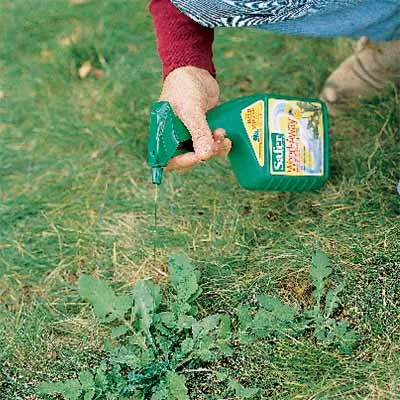
Q: What do I use to kill the weeds in my lawn without stressing the grass? What fertilizer should I use and how often?
—Jennifer, Dayton, Ohio
A: Roger Cook replies: There are several products that will kill weeds without stressing the lawn. You should go to your local garden center and ask for their recommendation. If possible, tell them exactly what kind of weeds you have in your lawn. There are weed killers used on walks, patios, driveways, and bed areas that will kill grass as well, so make sure they understand what you are trying to do. When treating weeds in a lawn I like to spot spray. This allows me to only treat the areas that need it, using the least amount of herbicide. On large areas you will probably need to use a granular herbicide peat with a spreader. Be careful to follow all directions on the bag. To stop the lawn from stressing out, make sure it is well watered before any herbicide application.
Here in New England I fertilize four times a year: April/May, mid-June, early September, and early November. In the April and November applications, I use a high-phosphorous fertilizer. (The phosphorous content is indicated by the middle number in the formula). This may be labeled as a starter or fall fertilizer. In June and September, I use a fertilizer higher in nitrogen (indicated by the first number in the formula), because nitrogen promotes top growth.
Combatting Crabgrass
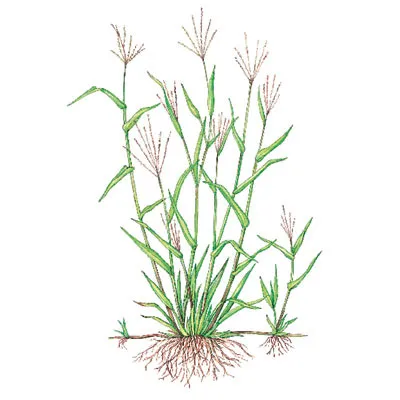
Q: I brought in some soil this spring to level a few low spots in the lawn and planted grass seed. Now I’m plagued with crabgrass. What can I do about it?
—Phil DeLuca, Jr., Alsip, ILl.
A: Roger Cook replies: Life would be so easy if only we could settle for crabgrass-covered lawns. Here’s the problem. When you plant grass in the spring, any crabgrass seed that’s around—and there’s plenty of it—will germinate and outcompete your delicate grass seedlings, particularly in a sunny location.
That’s why I prefer to plant grass in the fall, when crabgrass won’t fight you. Grass seedlings love the cool, wet conditions, and by the end of the growing season you’ll have a reasonable stand of grass. Then, in the spring, apply a pre-emergent weed control that will stop any crabgrass seeds from germinating.
Bothersome Bermuda Grass
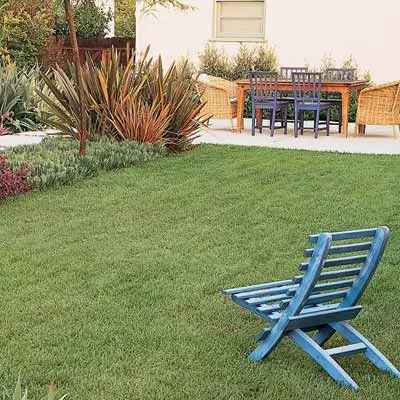
Q: I spent last year spraying the yard with a herbicide to get rid of a large crop of weeds — mostly Bermuda grass. Now that I’m ready to plant, the weeds have gotten worse in the backyard. I sprayed the whole yard equally, let the weeds die, tilled the yard under, waited for the regrowth, and repeated the actions. Why is there a massive regrowth in the back yard but not the front? And what can I do to get rid of the weeds once and for all?
—Geoff, Toledo, Ohio
A: Roger Cook replies: It may be that your back yard is sunnier than the front and promotes more growth. Or there is a greater source for the weed seeds in the back yard than the front. Identifying the weeds may also help you discover the problem. With some grasses, if they are not completely dead when you rotate, every little piece can send out new growth. If the weeds are blowing in you may be able to identify the source and eliminate them. Covering the back yard with plastic will keep the weeds from regenerating, but plastic is unsightly. Weed barrier may be a better solution. Another option is to get a covering on the ground: mulch, grass, and ground cover will all provide competition for the weeds. Also the timing of your spraying is critical. Here in New England spraying in June and July knocks down the weeds before they set seeds. The end of August and early September is the perfect time to roto-till and install a lawn.
Too Many Mushrooms
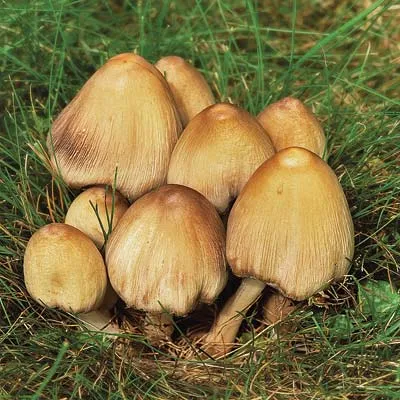
Q: Two years ago, after some trees were removed at the front of our house, the stump holes were filled with compost and seeded with grass. This year, along with the grass, we have tiny mushrooms that pop up in great profusion after it rains. Can we get rid of them without killing our lawn?
—Dave Williams, Springfield, MO.
A: Roger Cook replies: When you removed the stumps, you probably left behind most of the roots—and a lot of ground-up stump. That all serves as food for the network of underground fungi from which mushrooms sprout. And you probably lavished water on the new grass, didn’t you? Bingo, the perfect conditions for growing a bumper crop of mushrooms.
Rather than waiting for them to disappear, which could take quite a while, do the following:
• Cut back on watering and reduce fertilizer use to a minimum.
• Pull up any caps as soon as they appear. That doesn’t get rid of the underground fungus, but it stops spores from being released.
• Core-aerate the lawn in the fall and dethatch it in the spring; both of these encourage drainage and help dry out the soil.
• If none of these does the trick, dig out all the buried roots, and start over with fresh soil. Just be aware, you might be in for a lot of digging.
Q: Can I just mow down the mushrooms that crop up in abundance in my lawn after it rains?
—Alex, Bellevue, Washington
A: Roger Cook replies: Absolutely. These are just the fruiting bodies of fungi that are working in your soil. They will decompose after you mow them but probably reappear again after heavy rain.
Battling Bamboo
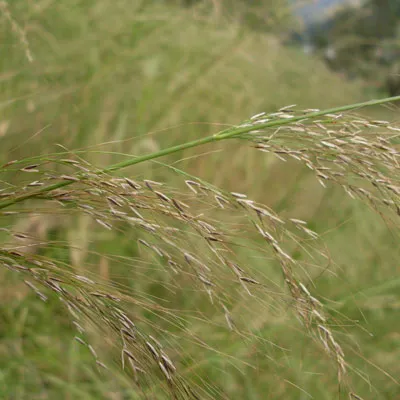
Q: When we moved into our house, we had a lot of bamboo growing on a hill beside a river. Every spring the bamboo shoots up and I have to cut it down weekly. Is there anything I can do to get rid of the bamboo permanently?
—Kevin, Pasadena, MD
A: Roger Cook replies: Too bad you can’t hire a panda to do this job. They happily eat up to 35 pounds of bamboo a day. But with pandas in short supply, the only practical way to get rid of bamboo is to keep cutting it down to ground level or spray it with an herbicide, or both.
A small chainsaw will make short work of the mature stalks. Follow up with a weekly trim using a lawn mower. Also, keep an eye out for shoots beyond the perimeter of the grove; some bamboos will send underground runners, called rhizomes, up to 25 feet from their base. By next season, hopefully, your bamboo will be gone.
If you decide to use chemicals on your bamboo, glyphosate-based herbicides are usually effective. Be sure to follow the instructions exactly: They kill any plant they come in contact with, and you don’t want them to reach the river. One approach I’ve found to be effective is to let the bamboo shoots grow to 2 or 3 feet in early spring, then spray them with herbicide. Then every time a new shoot reaches that height, spray again.
Here’s another option to consider: Rather than eliminate your grove entirely, cut it back to a manageable size, then contain it with a physical barrier. One off-the-shelf product uses thick interlocking polyethylene sheets buried about 3 feet in the ground. Containment systems do require vigilance because rhizomes will try to grow over the barrier. If any of them succeed, you’ll need to remove them.
By the way, not all bamboo is such a headache. “Clump-forming” bamboo is not invasive and doesn’t call for heroic containment efforts.
Killing Moss Without Killing Grass
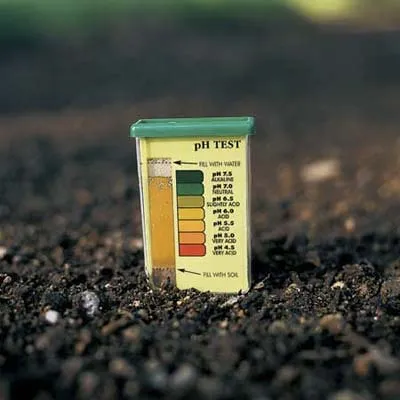
Q: Is there away to kill the moss in my lawn without killing the grass?
—Jake, Nashville, Tennessee
A: Roger Cook replies: There are several moss killers on the market that you can apply to the lawn. These work for the short term, but moss will return. Moss is an indication of an acidic lawn or too much shade on the lawn. Do a soil test on the lawn and apply lime to reduce the lawn’s acidity. To reduce shading, check trees around the area and prune or remove them as needed.
For more on the soil-testing kit shown here, see How to Seed a Lawn.
Creeping Charlie Takeover
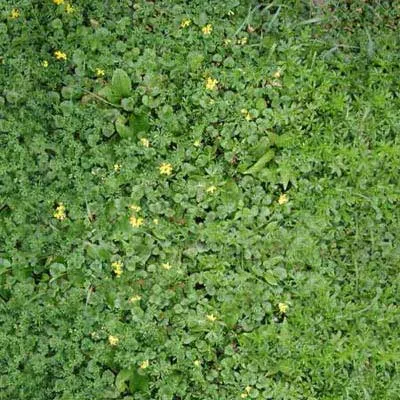
Q: We have what the neighborhood nurseries call “creeping Charlie” growing all over our lawn. We’ve tried pulling it out, digging it up, reseeding, overseeding, cutting the grass short, and leaving the grass long. Nothing seems to work. Help!
—Steve and Jan Christiansen, Palatine, Ill.
A: Roger Cook replies: Creeping Charlie, also called ground ivy or gill-over-the-ground, is a perennial and a highly invasive evergreen weed of the mint family. It loves conditions that grass doesn’t: shade, and soil that’s wet, acidic, or compacted. So if you see this weed, it’s a message that your lawn needs help.
Chemical weed killers might get rid of it, but unless you change the conditions that encourage this pest, it’ll just come right back. Get a soil test and add the nutrients or minerals that are missing. Prune or remove adjacent trees to admit more light. Reduce sources of excess water, such as runoff; don’t overwater the grass; and run a core aerator over it in the fall to reduce compaction. After aerating, spread a mixture of compost and sand over the grass so that the soil will drain better. If you reseed a somewhat shady area, use a grass blend suitable for shade. And if you still have problems after all that, give up on grass and plant a noninvasive groundcover that’s more to your liking.
Critter Control
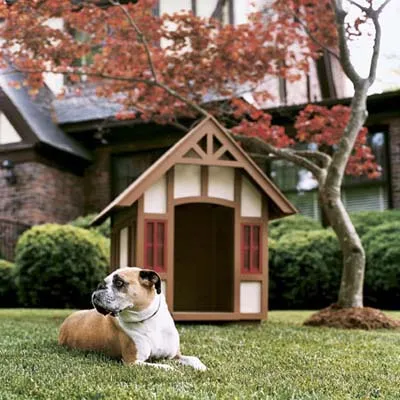
Doggy-Burned Patches
Q: Last fall, after we moved to our new house, our dog ruined various areas of the lawn with her urine. How do I rehabilitate these dead spots and keep more from forming?
—Jason Crownover, Westminster, Colo.
A: Roger Cook replies: Dog urine contains a high concentration of nitrogen, which kills grass the same way too much fertilizer in one spot will “burn” a lawn.
To repair these burned areas, remove any clumps of dead grass and loosen the soil with a hand-held claw tool. Level the damaged area with fresh topsoil, sprinkle seed and rake it in lightly, then water frequently to encourage germination. If there are lots of spots that need reseeding, buy one of the lawn-repair products that combine seed, fertilizer, and cellulose mulch in one bag. You can find them at pet stores and home centers.
To prevent future spotting, you have a couple of choices: Either follow your dog around with a hose to dilute her urine or train her to go only in one area, which you’ve covered with a thick layer of wood chips, mulch, or gravel. That’s what I would do if it were my dog.
Getting Rid of Gophers
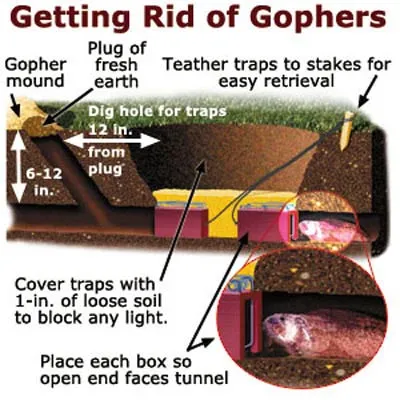
Q: We’ve been fighting gophers for the last three years. They’ve eaten the roots of my plants, and I’ve tried every remedy I’ve ever heard of, including putting human hair in the tunnels. What can we do to win this war?
— Elizabeth, Cleveland, TN
A: Roger Cook replies: Look on the bright side — at least you won’t have to aerate your lawn this year. Seriously, though, gophers are wily, destructive pests that throw up big mounds of earth willy-nilly across the landscape and destroy gardens and crops. Here’s a quick overview of the remedies for these rodents, but check with your local extension service on specifics that suit your area.
First of all, stuffing things down a gopher hole, including hair or those so-called sonic repellents, just doesn’t work. (Neither does dynamite, as Bill Murray proved in the movie Caddyshack.) I recommend box traps, which are the simplest and easiest type of gopher trap to use. You plant them in a main tunnel, which lies about 6 to 12 inches below the surface. (Find it by probing the ground around a mound on the side where you see a plug of fresh earth.) Then, following the illustrated directions, dig down and set two traps with their open ends facing opposite directions into the tunnel. No bait is needed, but be sure to wear gloves when setting the traps. You don’t want your scent to scare them away.
If you prefer not to trap, stay away from the poisons that contain strychnine. A poisoned gopher eaten by a cat, dog, or fox will poison that animal as well. Safer poisons use a bait laced with anticoagulants; internal bleeding kills the gopher (painlessly, I’m told) without endangering other animals. Just be sure to follow instructions for its safe use and disposal.
I’ve read that gophers can’t stand the smell of castor oil (can’t say I blame them) and that spraying a diluted mix on the ground is enough to make them skedaddle. There’s also some evidence that gophers don’t like mulch, so you could try mulching a buffer area around plantings. Or you could encourage predators to come feast on your rich gopher supply — installing owl boxes in a nearby woods might be a good start.
Wasps Nesting in Lawn
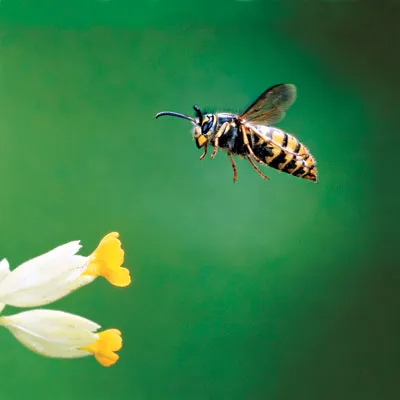
Q: What can I do to get rid of the yellow jackets living in the ground around my house?
—Ken McGarry, Chicago
A: Roger Cook replies: There are many kinds of wasps and bees that nest underground. Most are beneficial, not aggressive, and valuable as pollinators. But if you are sure that you have yellow jackets, the following strategies might get rid of them.
First, try flooding them with water in the evening, after they’ve returned to the nest. It may take several attempts over a period of days to drown them or encourage them to move elsewhere. Or you could try covering each hole with plastic—again, in the early evening—and seal it against the ground with bricks or blocks for a few days.
If that doesn’t cook them or discourage them, you’ll probably have to use an insecticide. There are many formulations of these chemicals, including some poison-free products such as mint oil. Availability varies from region to region, but you should find what you need at a garden center or home supply store.
Dealing with white grubs, chinch bugs, or other such pests? We’ve got you covered in How to Deal With Common Lawn Problems
Paw-Proof Yard

Q: Lucy, our 2-year-old Doberman, is a wonderful dog, but by running around in our backyard she’s killing what little grass we have. I’d like a nice grass yard but don’t know what to do.
— Don, Milwaukee, WI
A: Roger Cook replies: Dogs will be dogs, and they do love to run. And if a dog is confined to one area, particularly if it’s chained to a post or to a cable that allows the dog to move back and forth, lawn damage is unavoidable. In this case, forget trying to save the grass. Remove what’s there and replace it with a wide swath of mulch or sand, contained with edging. These materials won’t hurt a dog’s feet, the way gravel or pea stone can, and they can easily be raked back into place as needed. Artificial turf might also work, if the area isn’t too large. I’ve installed it under backyard swingsets. It stands up to toddlers, so maybe it would work with Lucy.
Another approach would be to use one of the porous paving systems designed to help grass withstand driveway and parking-lot traffic. These perforated plastic or masonry materials, which are strong enough to support cars and trucks, contain many holes that protect the grass and its roots from damage while allowing water to drain through. Installing these systems requires some excavating, filling (with a good mix of sand, compost, and loam), replanting (with sod plugs), and waiting before the grass is strong enough. But once the lawn is established, it should be able to withstand Lucy. Just be sure to discuss your intentions with the manufacturer first. You don’t want to install anything that will cut her feet.
What to Do When Grass Won’t Grow
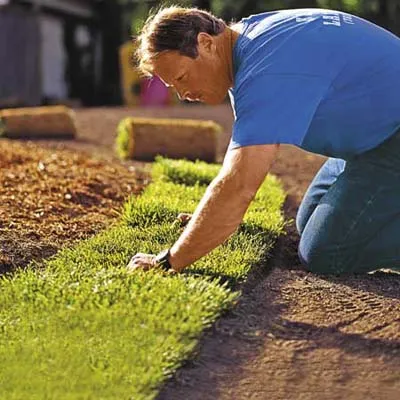
Grass: Impossible?
Q: I can’t seem to get grass to grow well in a little patch between my front walk and the driveway, near a few pine trees. Would I have better luck with sod?
—Brandon Carpenter, Perry, Mich.
A: Roger Cook replies: Grass is grass, whether you grow it from seed or lay it out as sod. If the growing conditions aren’t right, it won’t survive.
First of all, make sure the area gets at least five hours of sunlight a day. If the pines are blocking the sun, you could cut them down, but that’s a drastic step given the size of your patch. Or you could just forget the grass and plant a shade-loving ground cover, such as pachysandra, instead.
If there is enough light, the soil probably needs help. Have it tested by your cooperative extension service and follow their recommendations about what nutrients or minerals to add. After you have the results, turn over the top 6 to 8 inches of soil, work in sand or compost if it’s compacted, and use a shovel to thoroughly mix it. Now spread lawn-starter fertilizer and the recommended additives, and rake them into the top layer of soil. Only then should you seed or sod.
The way I see it, you might as well put down sod. It won’t cost much to cover your small area and you’ll get some instant gratification for all your hard prep work.
Growing Grass Under a Shade Tree
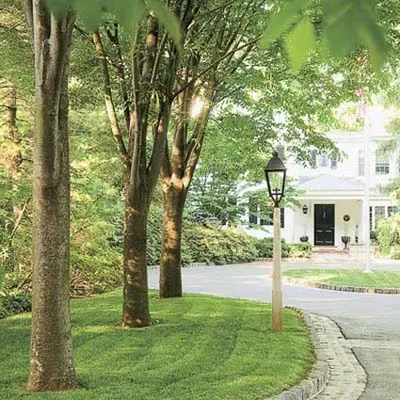
Q: We live in an area with lots of trees, so my problem is moss growing in the lawn. When we tear it out, it always comes back. How do I get rid of it for good?
—Mike Leibensperger, Jim Thorpe, Pa.
A: Roger Cook replies: How much do you love your trees? Your yard is telling you that there’s too much shade for grass to compete successfully against moss. If you really want a lawn there, either cut down some trees or prune them aggressively to let in more light.
Also, test your soil. Moss loves acid soil, so you may need to add lime to “sweeten” it. That will encourage grass and discourage moss.
Here’s another approach, if you can live with less lawn: In those areas where the moss is thickest, plant a shade garden, using shrubs, perennials, and ground covers that tolerate the existing conditions. In that setting, your moss might actually be a nice ground cover. You could also add some large rocks and maybe even a bench where you could sit and cool off after mowing the healthy part of your lawn.
Preventing Moss in a Shady Lawn
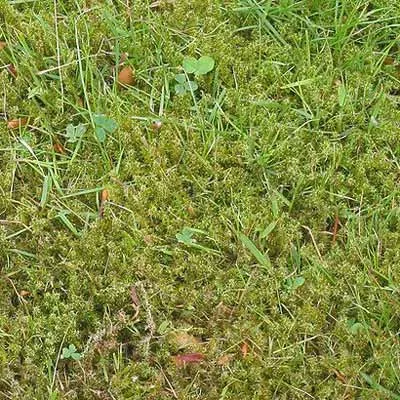
Q: Parts of my lawn can be extremely soft when wet, and when I cut my grass recently I left deep ruts across the softer parts. This didn’t tear up the turf or anything, but the ruts are un-sightly. What can I do to repair this damage?
— Chuck, Cordova, TN
A: Roger Cook replies: First, let’s talk about preventing further damage. The obvious advice — don’t mow when your lawn is wet — will not only prevent the rut problem but will give you a better cut too. If the lawn is wet so often that this regularly interferes with your mowing schedule, have a landscape contractor take a look. You probably have a drainage problem that needs attending to.
Now on to fixing the ruts. A lot of people tackle this the wrong way: by filling the ruts in with dirt and then seeding the area. But filling doesn’t relieve the compaction, and the new grass never quite blends with the surrounding turf.
The best way to fix ruts is to loosen the soil. For shallow ruts no more than a few inches deep, take a spade fork and sink it into the ground alongside the rut at a 45-degree angle. With the fork’s tines buried under the bottom of the rut, gently push down on the handle and lever the sod up about 1 or 2 inches above the surrounding area. Then remove the fork and let the sod settle over time to a level that’s even with the neighboring lawn.
Ruts more than 4 inches deep have to be treated differently. Using a lawn edger or a spade, make a lengthwise cut through the grass at the bottom of the rut, and use a fork to fold back the sod on each side of the cut. Now, loosen the soil in the rut by turning it over with a spade, leaving it an inch or two higher than the undisturbed soil. Add more soil if necessary. Then flip back the grass, pat it down lightly, and water the area. If you do this right, no one will ever know the ruts were there.
One caution: Even if the ruts aren’t deep, proceed carefully if you have an underground irrigation system. One misplaced fork tine or shovel blade could put it out of commission.
Lawn Bald-Spot Cure

Q: We can’t get grass to grow in the space between the house and the flower bed around our dwarf Japanese Maple. Is the area just too narrow for grass, or has something else been causing the problem?
— Ed and Sandy Pasko, Torrington, Conn.
A: Roger Cook replies: Grass doesn’t mind narrow areas—as anyone who’s weeded out the joints in a brick walkway can tell you. From looking at your photos, I’d say you have bigger problems with compacted soil from too much foot traffic and too much shade from your maple. Loosening the soil to a depth of 6 to 8 inches with a D handled garden folk will eliminate the compaction temporarily. Pruning might allow more sunlight to reach the ground. But my recommendation for small, struggling areas of lawn is to eliminate them. First rototill the area to get rid of the grass—but not deeply enough to damage the tree roots—and put in stepping stones to take care of the traffic. Then plant shade-loving groundcover such as epimedium or vinca.
BROWN GRASS, BURNS, STRIPES, MORE
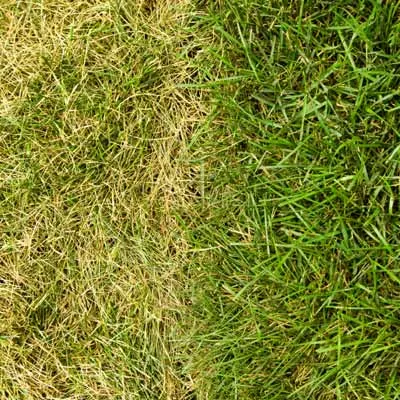
Spring Lawn Stripes
Q: Every summer, when things begin to dry out, we get three brown stripes in our lawn. I’m guessing that these are the leach lines to the septic system. Is there anything we can do to prevent this from happening
— George, Xenia, Ohio
A: Roger Cook replies: You’re probably right about what’s causing the stripes, but just to make sure, get a copy of the septic plan and see if the lines correspond to it. The plans might be with the deed for your house, or at your board of health or building department. If the stripes line up with the pipes, the field probably has too much stone or sand too close to the surface, which would cause the ground to dry out too quickly. There should be about 3 to 6 inches of stone or sand above the drain field pipes, with 6 to 12 inches of topsoil above that. Poke around gently with a shovel to see how deep the soil goes.
If your digging turns up stones or sand, you’ll have to dig some of it out and replace it with loam. First, mark the locations of the areas that dry out. Then in the fall, when the grass is no longer dormant, rent a sod cutter and remove the affected lawn. It’s always better to save the existing grass and reuse it because different sod or seed might take years to blend in. Lay the sod aside on burlap and keep it wet. Then dig out 6 inches of sand or stone and replace it with 5 inches of good-quality loam. Be careful with your shovel; you don’t want to damage any pipes. Compact the loam slightly so that it won’t settle, then put the sod back. Take your time to do a careful job and in a few months you won’t know where the repairs were.
Now, if the septic field doesn’t correspond to the brown areas, ask a local utility for the name of your local “one-call” center, which will come out and mark the location of all buried water, gas, or telephone lines. Once you know where it’s safe to dig, dig down and see what’s causing the area to dry out. You’ll probably find sand, stone, or just compacted soil, but I’ve uncovered asphalt walkways buried under the grass.
Fertilizer-Burned Lawn
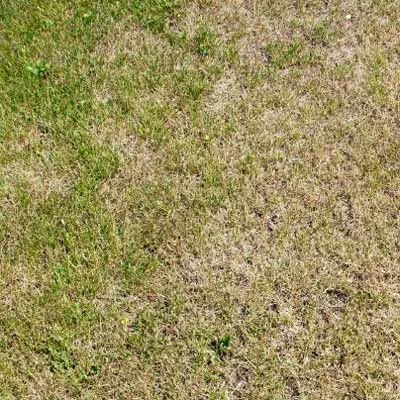
Q: How do I repair yellow burn marks from too much fertilizer?
— Sharon, Egg Harbor Township, New Jersey
A: Roger says: Once the burn marks show up there is nothing you can do but replace the grass. I would cut out the area, remove 1 inch of soil, add new soil and seed, or sod, depending on which would blend in faster, which is usually the seed. If you ever spill fertilizer over a small area, rake it up and remove as much as possible, then water the area heavily for several weeks.
Brown Grass Solution
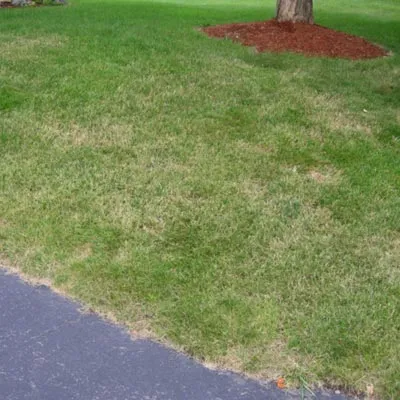
Q: My lawn was just put in three months ago and it seems to be burned from the heat. We try to water it in the late afternoon when it’s cooler, but it seems to be getting worse. Should we fertilize?
—Larry, Doylestown, Pennsylvania
A: Roger Cook replies: I would like you to water early in the morning instead of the afternoon. Watering in the afternoon can leave the grass blades wet all night, which can lead to fungus. This could be what you are seeing.
But if I had to guess, I would say it’s probably a lack of fertilizer that’s giving you this appearance. The lawn should have been fertilized twice by now, once 3 to 4 weeks after the initial fertilizing and again 6 to 8 weeks later. All the extra watering you’re doing is leaching fertilizer out of the soil or driving it down beyond the development of the root system and making it unavailable to the grass. Try refertilizing with a starter fertilizer (low nitrogen, higher phosphorous). But be very careful when spreading it. These “burn” spots are sometimes areas where fertilizer has not been properly applied.
Getting Rid of Lawn Ruts
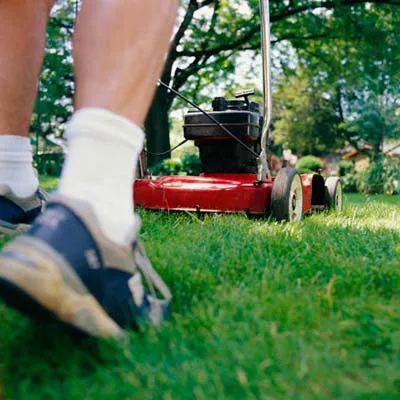
Q: Parts of my lawn can be extremely soft when wet, and when I cut my grass recently I left deep ruts across the softer parts. This didn’t tear up the turf or anything, but the ruts are un-sightly. What can I do to repair this damage?
— Chuck, Cordova, TN
A: Roger Cook replies: First, let’s talk about preventing further damage. The obvious advice — don’t mow when your lawn is wet — will not only prevent the rut problem but will give you a better cut too. If the lawn is wet so often that this regularly interferes with your mowing schedule, have a landscape contractor take a look. You probably have a drainage problem that needs attending to.
Now on to fixing the ruts. A lot of people tackle this the wrong way: by filling the ruts in with dirt and then seeding the area. But filling doesn’t relieve the compaction, and the new grass never quite blends with the surrounding turf.
The best way to fix ruts is to loosen the soil. For shallow ruts no more than a few inches deep, take a spade fork and sink it into the ground alongside the rut at a 45-degree angle. With the fork’s tines buried under the bottom of the rut, gently push down on the handle and lever the sod up about 1 or 2 inches above the surrounding area. Then remove the fork and let the sod settle over time to a level that’s even with the neighboring lawn.
Ruts more than 4 inches deep have to be treated differently. Using a lawn edger or a spade, make a lengthwise cut through the grass at the bottom of the rut, and use a fork to fold back the sod on each side of the cut. Now, loosen the soil in the rut by turning it over with a spade, leaving it an inch or two higher than the undisturbed soil. Add more soil if necessary. Then flip back the grass, pat it down lightly, and water the area. If you do this right, no one will ever know the ruts were there.
One caution: Even if the ruts aren’t deep, proceed carefully if you have an underground irrigation system. One misplaced fork tine or shovel blade could put it out of commission.
Construction-Damaged Lawn
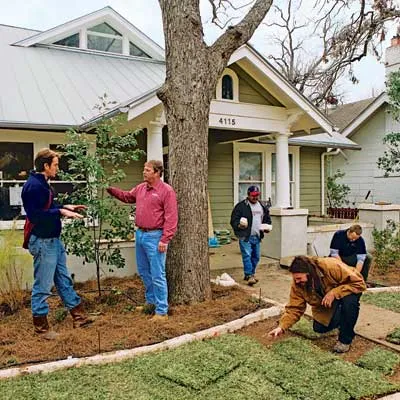
Q: We’ve made a number of changes in our front yard over the past couple of summers — removed several large trees, rebuilt a stone wall, and added a bluestone walkway. The work was hard on our lawn and we’ve repaired the obvious damage, but with all the trucks and tractors driven around out there, I wonder if the soil has been packed down too much for the grass to grow. How can I tell?
— M. David, Southbury, Connecticut
A: Roger says: You’re right—construction traffic is hard on lawns, even when it doesn’t actually tear up the grass. You can pretty much assume that your lawn has been compacted, making it hard for roots to get air and water. (Heavy machinery isn’t the only culprit: Constant foot traffic can turn soil as hard as pavement.) You can tell whether your lawn is compacted by pushing a long screwdriver into the turf. If it doesn’t easily slide in more than 6 inches or so, the soil is too dense. Slow-draining soil is another sign of compaction. To correct this problem, you’ll need to rent a core aerator. Be sure you get the kind that removes small plugs of earth from the lawn and scatters them over the grass. The holes it leaves behind provide a way for air and water to reach the root zone. Grass roots fill the holes in a few weeks; the plugs dissolve away after a month or so.
Core aerating is one of the best things you can do for a lawn, even if it hasn’t been driven over. I run the aerator over the entire lawn in one direction, then make a second pass at 90 degrees to the first. Immediately afterward, I top-dress the lawn with 1/4 to 1/2 inch of aged leaf compost; if you don’t have a compost pile, get it from a garden or local recycling center. I apply compost with a spreader if I can, but if it clogs up, I use my hand to flick the compost off the end of a flat shovel. Next, I scratch it around with a steel rake so it doesn’t just sit on top of the grass. In areas where drainage is poor, I add sand.
Aerating is best done in the fall. (In the spring, it encourages crabgrass.) If you aerate and top-dress every fall for three years, you’ll notice a substantial improvement in your lawn.
Dealing With Unwanted Grass

Grass Overtaking the Vegetable Garden
Q: I planted a vegetable garden on a plot that was fully covered with grass, and I’m having a hard time keeping the weeds and grass from overgrowing the plants. Is there a product to control garden weeds?
—Bethany, Blue Ridge, Georgia
A: Roger Cook replies: One thing you can do is block sunlight from getting to the weeds. This can be accomplished using plastic, newspaper, or weed barrier. Plastic and newspaper do not allow water to pass through, so they are not going to help the garden grow. Weed barrier will let water pass through however. My suggestion is to purchase weed barrier in a size that is economical for your area. Cover the entire area, anchoring the barrier with brick or wire clips available where you buy the product. Now you can cover the weed with mulch, such as wood chips or grass clippings from a non-chemically treated lawn. When you go to plant you can cut a small hole in the weed barrier and put in your plant. If the garden is already planted, roll out the weed barrier carefully between the plants and mulch. You may get a few weeds growing in the mulch but it will be minimal compared to the problems you have now.
Lawn Invading Flowerbeds

Q: Even after installing black plastic edging and applying several inches of mulch, I find that grass from the lawn still invades our vegetable and flower gardens. How can I keep the lawn from taking over?
—Doug; Hastings, MI
A: Roger Cook replies: Sounds like the edging isn’t deep enough. I usually use steel edging that is at least 4 inches deep, and occasionally roots will even go under that. If I really want to be sure the grass won’t invade the bed, I’ll use brick standing on edge (8 inches) or cobbles (10 to 12 inches). These methods are a lot of work, and the materials are not cheap to buy.
The inexpensive way to stop the roots is to buy an edger — a hand tool that has a long wooden handle with a thick metal blade on the end. Work the edger along the lawn an inch or two away from the bed, cutting that much off the grass 6 to 8 inches deep, straight down. Leave this vertical edge exposed, with a slope on the other side back up to the level of the bed. Make sure when you mulch that you don’t fill in this V-shaped channel, or the grass will grow into it.
Remove the cut-off grass from the channel and add it to your compost pile. If you don’t, it will end up growing into the bed.
Once or twice a month, run down the edge with a string trimmer turned vertical and trim off any shaggy ends. Be sure to wear safety glasses and ear protection. Between the trimming and the air space in the channel, this will inhibit root growth.
Removing Established Grass
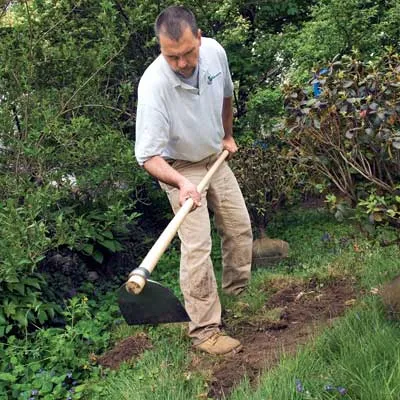
Q: What’s the easiest way to get rid of grass for patio or walkway installation?
A: The first step in building a new walkway or patio, or planting a new garden bed, usually involves getting rid of the grass. Fortunately, it’s easier to eradicate than to grow, especially if you use the right tools and techniques. Here are the methods This Old House landscape contractor Roger Cook uses to scalp a lawn.
Grub hoe. For small projects, use muscle power. With a quick chop, the hoe’s 8-inch-wide blade cuts through roots; a tug on the handle rips turf out of the ground. Resist the temptation to swing the tool like a pickax; your back and arms will give out before the job is done. Instead, take short swings, just hard enough to penetrate the root layer—a couple of inches deep, at most. Walk forward as you work, so the cut pieces of sod don’t cover up the grass to be removed.
Sod cutter. For large projects , a gas-powered version from the rental center is the way to go. Using a wide, narrow blade that swings back and forth just below root level, a sod cutter swiftly severs roots, clearing a swath in one swift pass. Then just roll up the grass strips and replant them elsewhere, if you wish.
Lawn Mower Matters
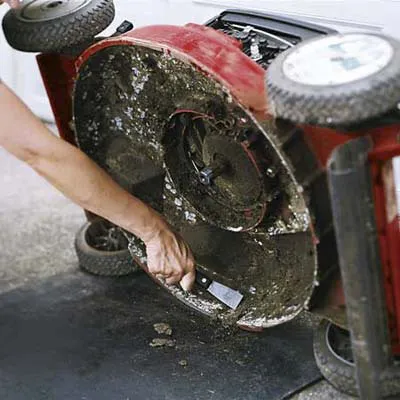
Stop Sticky Grass
Q: After reading your article on lawn care in the April 2004 TOH issue, I tried out household vinegar as an organic weed control on some dandelions in my backyard. Within a couple of days, they looked pretty dead. Could I use this method to kill the existing lawn?
— Mark, by e-mail
A: Roger Cook replies: Vinegar, or acetic acid, is one of the newest things in weed control. When sprayed on, it has an almost immediate impact, as you discovered. The problem is that it doesn’t kill the roots, so some weeds grow back over time.
To kill a lawn completely, you could spray the household vinegar on weeds and grass that are actively growing, and after a few days, follow up with glyphosate (Roundup) on anything still alive; that would greatly reduce the amount of herbicide you need. Or, you could apply another dose or two of vinegar before Rototilling and reseeding. You may get a few weeds, but don’t use vinegar or herbicides on them yet. Wait until you’ve cut the new grass three or four times before launching another chemical attack.
Sharpening Tools
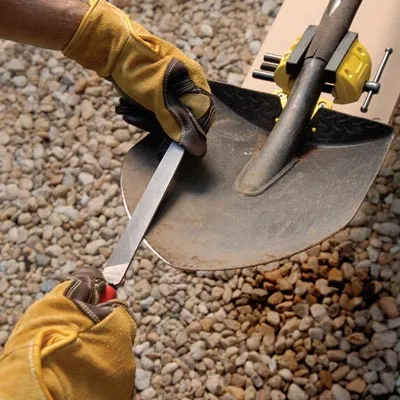
Q: Am I supposed to sharpen my shovel, posthole digger, hoe, and other digging tools? How do you do that?
—Jerry Comeaux, Youngsville, LA.
A: Roger Cook replies: Yes, it is a good idea to keep all your digging tools sharp because you’ll get more work done in less time and with less effort. The maintenance is easy: All you need is a good pair of heavy leather gloves, a 12-inch mill bastard file, and a vise. Here’s how I keep my digging tools in shape:
1. For safety and stability, secure the tool in the vise by its handle—dished-side up, in the case of shovels and posthole diggers, and blade pointing straight up for hoes.
2. Hold the file with two hands, skewed slightly to the side and flat against the original bevel on the cutting edge. If there’s no bevel left, hold the file tilted 45 degrees off the tool’s face. Push the file toward the handle in straight, even strokes, moving it in only one direction.
3. When the angle has been restored, lay the file flat against the back of the bevel and remove the burr, which forms as you file the metal. A couple of strokes is all you need.
4. Wipe the metal with a penetrating oil, such as WD-40, to discourage rust. If a tool is severely dented or worn, a 4-inch angle grinder fitted with a medium-grit aluminum-oxide wheel will take care of snaggly edges in short order. Be sure to wear hearing protection and goggles when you switch it on. Hold the grinder so that the sparks fly toward the shovel, not at you. When you’re done, touch up the bevel with a file.
Once a tool is sharp, you should only need to file it yearly to keep it keen.
Easy-Start Mower
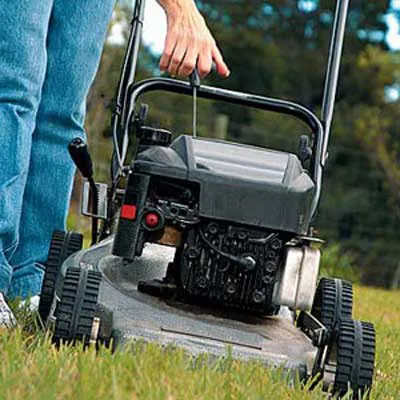
Q: I am an 80-year-old who still makes a garden and mows her yard. As I’ve gotten older, however, I’ve been having a hard time pulling the starter rope on my lawn mower. Is there anything I can do now to prevent this problem next year?
— Estelle, Checotah, OK
A: Roger Cook replies: The starter rope of a mower usually gets slightly easier to pull as the mower gets broken in, so it’s possible that something is obstructing the rope or the blade. Following the directions in the owner’s manual, try taking off the pull-start housing and cleaning it out to dislodge any debris that may be inside. This work is pretty easy to do, but you might also have a bent crankshaft, which will need to be fixed by an experienced small-engine repair guy.
Or you might consider buying a new mower without a cord. You can take your pick of electric or battery-powered models, as well as gas mowers with electric starting. With that last type, all you have to do to fire up the engine is hold down a safety-control bar and turn a key. This labor-saving feature raises the price about $100 over an equivalent manual-start gas mower.
Grass Clippings as Mulch
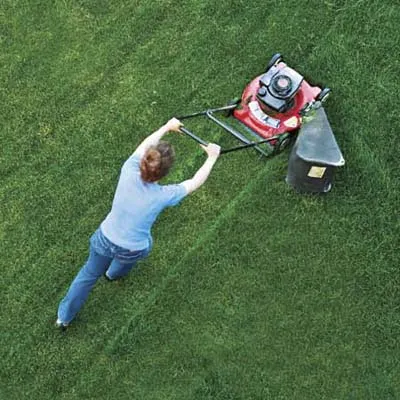
Q: Is it safe to use grass clippings from a chemically treated lawn as mulch for other plants?
—Jamelle, Elkins, West Virginia
A: Roger Cook replies: Because I have no definite proof that you can, I would recommend that you don’t. I worry that the herbicide on the grass could release into the soil as the grass breaks down and be picked up by other plants.
However, if you’re not treating the lawn with chemicals, grass clippings do make a great mulch.
